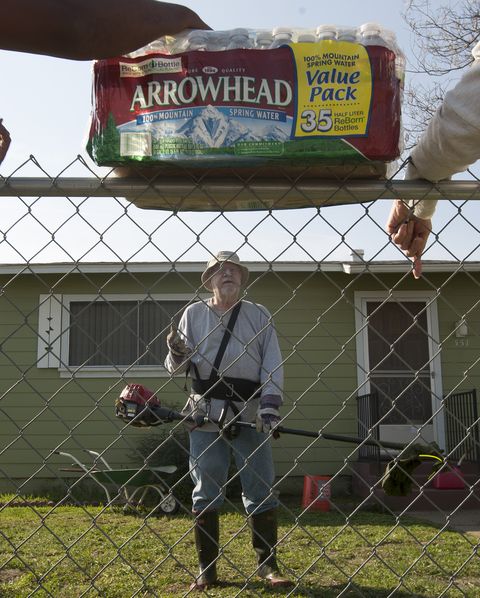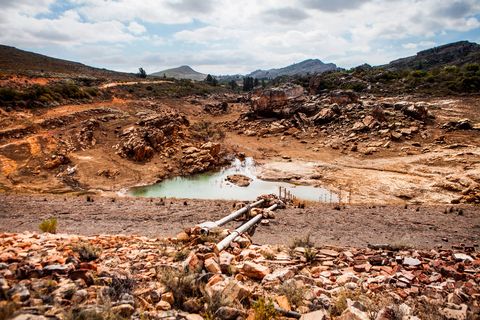A Lesson on Happiness From a 92 Year Old
I agree with her 100%!
Posted by Power of Positivity on Monday, October 30, 2017
Category: Education
Vote today to save the everglades and Florida waters!

Everglades-Trust
August 25, 2018
Like George was calling out Big Sugar by name: “They spend billions of dollars every year lobbying, lobbying, to get what they want. Well, we know what they want. They want more for themselves and less for everybody else.
But I’ll tell you what they don’t want: They don’t want a population of citizens capable of critical thinking. They don’t want well informed, well educated people capable of critical thinking. They’re not interested in that. That doesn’t help them. That’s against their interests.”
Like George was calling out Big Sugar by name: “They spend billions of dollars every year lobbying, lobbying, to get what they want. Well, we know what they want. They want more for themselves and less for everybody else. But I'll tell you what they don’t want: They don’t want a population of citizens capable of critical thinking. They don’t want well informed, well educated people capable of critical thinking. They’re not interested in that. That doesn’t help them. That’s against their interests.”
Posted by Everglades-Trust on Saturday, August 25, 2018
Costa Rica will be 100% renewable by 2021
U.S. Senator Bernie Sanders — US Senator for Vermont
August 26, 2018
Despite Trump and Scott Pruitt, the world is making progress to address climate change. Costa Rica is proving that it’s possible to rapidly transition away from fossil fuels to renewable energy. (via The Years Project)
Despite Trump and Scott Pruitt, the world is making progress to address climate change. Costa Rica is proving that it's possible to rapidly transition away from fossil fuels to renewable energy. (via The Years Project)
Posted by U.S. Senator Bernie Sanders on Sunday, August 26, 2018
1 in 3 Americans have less than $5,000 saved for retirement
CNBC – Money
1 in 3 Americans have less than $5,000 saved for retirement—here’s why so many people can’t save
Kathleen Elkins August 27, 2018
That means about a third of Americans have only a few thousand dollars, or less, put away for their golden years.
Of course, some people are more prepared: A quarter report having $200,000 or more stashed away, while 16 percent have between $75,000 and $199,999. But overall, Northwestern Mutual found that Americans with retirement savings have an average of $84,821 saved, which is far from enough. Experts typically recommend trying to accumulate at least $1 million.
Meanwhile, a new survey from Bankrate finds that 13 percent of Americans are saving less for retirement than they were last year and offers insight into why much of the population is lagging behind. The most popular response survey participants gave for why they didn’t put more away in the past year was a drop, or no change, in income.
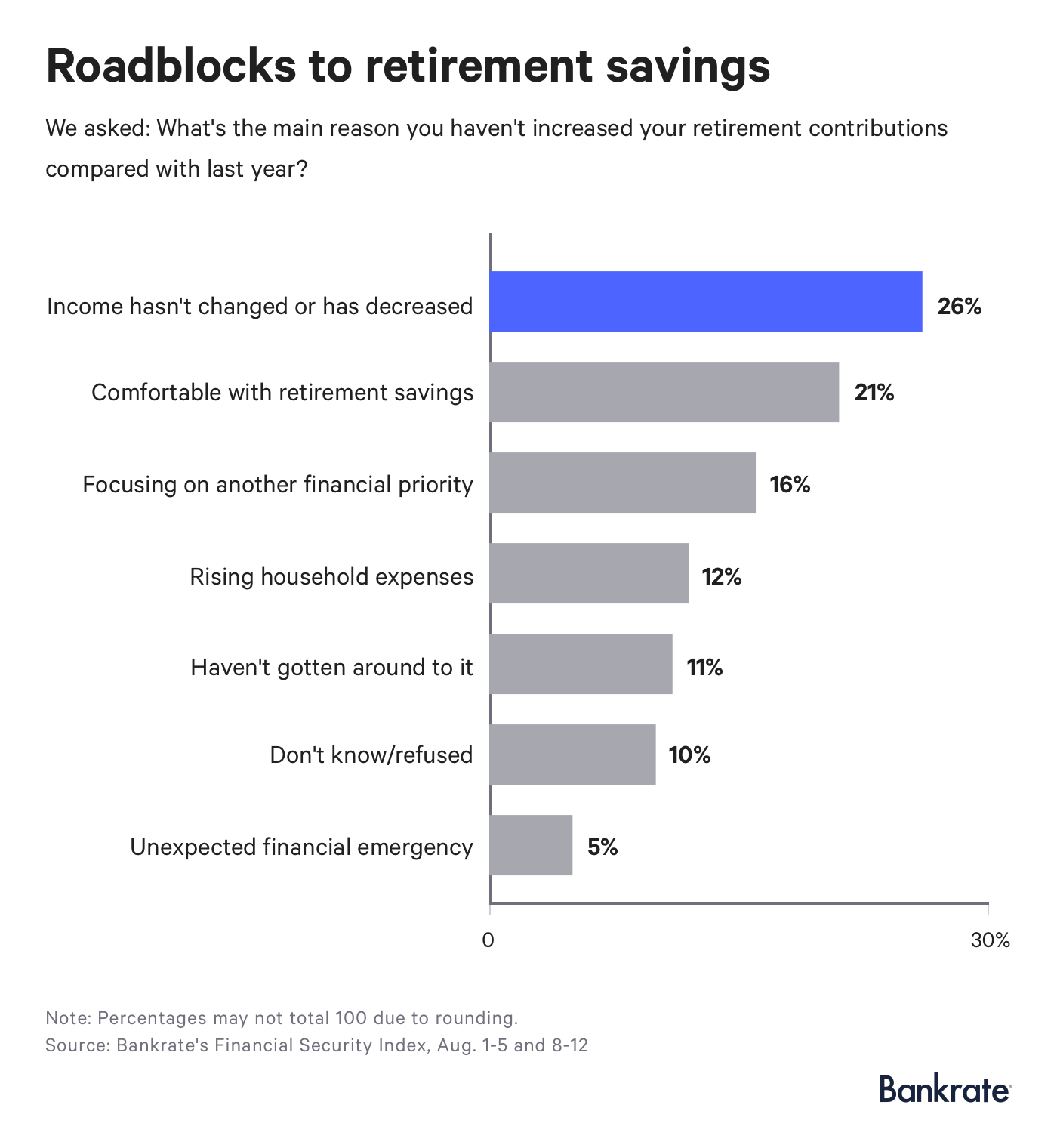
“That’s consistent with federal data that show real wages have barely budged in decades,” Bankrate reports. According to the Pew Research Center, the average paycheck has the same purchasing power it did 40 years ago.
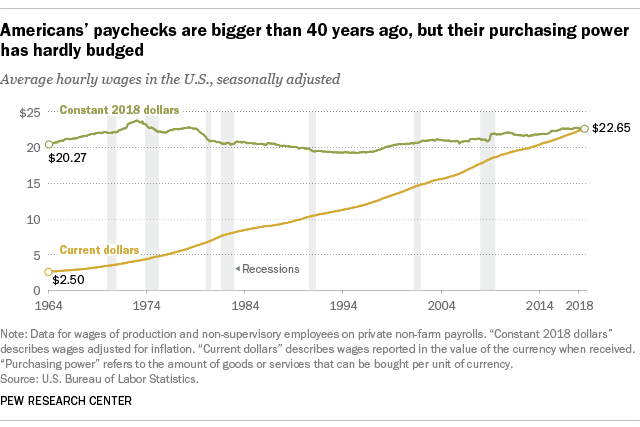
Day-to-day costs continue to soar, and salaries don’t go as far as they once did to cover the necessities, author and executive director of the Economic Hardship Reporting Project Alissa Quart tells CNBC Make It. That makes it more difficult to set aside money for the future.
Still, the longer you put off planning for your golden years, the farther behind you’ll fall.
The good news is there are ways to make progress without feeling cash-strapped or committing to any drastic lifestyle changes. Here are three effective strategies:
1. Start ASAP. The sooner you begin putting your money to work, the less you’ll have to save each month to reach your goals, thanks to the power of compound interest.
If you start at age 23, for instance, you only have to save about $14 a day to be a millionaire by age 67. That’s assuming a 6 percent average annual investment return. If you start at age 35, on the other hand, you’d have to set aside $30 a day to reach seven-figure status by age 67.
Ideally, you’ll want to work your way up to setting aside at least 10 percent of your pretax income, but if you’re only comfortable with setting aside 1 percent, start there!
Check online to see if you can set up “auto-increase,” which allows you to choose the percentage you want to raise your contributions by and how often. This way, you won’t forget to up your contributions or talk yourself out of setting aside a larger chunk when the time comes.
If you can’t find the feature online, call your retirement plan provider to find out what’s possible.
3. Bank any surplus money. Whenever you come across any extra cash — a bonus, birthday check or small windfall — rather than blowing it on a new pair of shoes or a vacation, send at least a chunk of it straight to savings.
To resist the temptation to spend any surplus money, deposit it right away, so you never even see it.
Don’t miss: The economy is booming, yet Americans are struggling. An award-winning author explains why
 Here’s how this North Carolina couple could retire in their 30’s.
Here’s how this North Carolina couple could retire in their 30’s.
Trump admin ‘turned its back on young people’
Yahoo – Finance
Student loan watchdog quits: Trump admin ‘turned its back on young people’
Farmers using ducks instead of pesticides
August 2018
It might sound quackers but it’s catching on. Learn more about the future of farming:
Farmers across China, Japan, Iran and France are using ducks instead of pesticides
It might sound quackers but it's catching on. Learn more about the future of farming: https://wef.ch/2IjsVdR
Posted by World Economic Forum on Thursday, August 2, 2018
Victory for Clean Water
The Water Crises Aren’t Coming—They’re Here
Esquire
The Water Crises Aren’t Coming—They’re Here
For eons, the earth has had the same amount of water—no more, no less. What the ancient Romans used for crops and Nefertiti drank? It’s the same stuff we bathe with. Yet with more than seven billion people on the planet, experts now worry we’re running out of usable water. The symptoms are here: multiyear droughts, large-scale crop failures, a major city—Cape Town—on the verge of going dry, increasing outbreaks of violence, fears of full-scale water wars. The big question: How do we keep the H20 flowing?
 Sean Freeman
Sean Freeman
I. All the Water There Is
Here’s a concept: paper water. Paper water is water the government grants certain farmers who are drawing water from a river or a watershed in, say, California. The phrase describes the water the farmer, under premium conditions, is entitled to. Practically, however, paper water is mostly notional water, conceptual water, wish water, since over the years California has awarded many times as much paper water as there is actual water—which, to distinguish it, is quasi-legally called wet water. Some paper water might be made real during years of exceptional abundance, but most of it will forever be speculative and essentially useless, since it can’t realistically be traded, having no value. Paper water thus amounts to a type of hypothetical currency, backed by the Bank of Nowhere, Representing Nothing since 1960 (or thereabouts), when modern water troubles arrived in America and especially in California, where the wildly expanding citizenry required new state and federally managed water systems run by Watercrats.
Paper water is also a signifier of a domestic and global concern called peak water, a term proposed in 2010 by the hydrologist Peter Gleick in a paper he wrote with Meena Palaniappan that was published in Proceedings of the National Academy of Sciences.Gleick meant the phrase to be applied to worldwide circumstances, such as those that currently prevail in Cape Town, South Africa, where, as a result of a ferocious three-year drought, the taps might before long run dry, possibly in 2019—Day Zero, it’s been called.
The U. S. is also afflicted. In fact, Gleick regards California, with its relentless, outsized, and wildly conflicting demands on water, as a “laboratory for all of peak water’s concerns.” Peak water derives conceptually from peak oil, a phrase first used by a geophysicist named M. King Hubbert in 1956. Peak oil means that the planet has only so much oil, and that eventually it will grow sufficiently scarce that what remains will be too expensive to collect. Hubbert predicted that U. S. oil production would reach maximum output between 1965 and 1975, and in 1970 it did, but it has risen lately because of new means of recovering oil, such as fracking. Some people still believe in peak oil, and others think there will always be plenty of oil, because there is more we haven’t found yet.
That water was in a position similar to oil occurred to Gleick when people would ask if he thought that the world, with its population growing alarmingly and climate change causing certain places to become disastrously water-soaked (South Asia, Texas) while others (Cape Town, California) are water-starved, would ever use up its water. “My first reaction was ‘We never run out of water,’ ” Gleick says. “But there’s groundwater in China and India and the Middle East and in America in the Midwest and California that we really are using up just like oil.”
Water cannot be created or destroyed; it can only be damaged. When Gleick says we’ll never run out, he means that at some point, millions of years ago, there was all the water there is, a result of the law of the conservation of matter. Having evaporated from lakes and rivers and oceans and returned as snow and rain, the water we consume has been through innumerable uses. Dinosaurs drank it. The Caesars did, too. It’s been places, and consorted with things, that you might not care to think about. In theory, there’s enough freshwater in the world for everyone, but like oil or diamonds or any other valuable resource, it is not dispersed democratically. Brazil, Canada, Colombia, Peru, Indonesia, and Russia have an abundance—about 40 percent of all there is. America has a decent amount. India and China, meanwhile, have a third of the world’s people and less than a tenth of its freshwater. It is predicted that in twelve years the demand for water in India will be twice the amount on hand. Beijing draws water from an aquifer beneath the city. From being used faster than rain can replenish it, the aquifer has dropped several hundreds of feet in the last forty years, and in places the city is sinking four inches every year.
As for the world’s stock, however, nearly all of the water on earth is salty; less than 3 percent is fresh. Some of that is in rivers, lakes, aquifers, and reservoirs—the Great Lakes contain one fifth of the freshwater on the earth’s surface—and we have stored so much water behind dams that we have subtly affected the earth’s rotation; but two thirds of all the freshwater we have is frozen in the earth’s cold places as ice or permafrost, leaving less than 1 percent of the world’s total water for all living things. Much of that gets a rough ride. American ponds and streams and lakes and rivers contain fungicides, defoliants, solvents, insecticides, herbicides, preservatives, biological toxins, manufacturing compounds, blood thinners, heart medications, perfumes, skin lotions, antidepressants, antipsychotics, antibiotics, beta blockers, anticonvulsants, germs, oils, viruses, hormones, and several heavy metals. Not all of these are cleansed from water before we drink it.
There are two kinds of numbers, I believe, big ones and little ones, but here are some big ones by way of context: According to the World Health Organization, among the two billion people who have no drinking water provided to them, 844 million travel more than thirty minutes to a river or a tap, where they sometimes receive water contaminated by human excrement. Such water has the risk of diarrhea, cholera, dysentery, typhoid, and polio. Nearly 850,000 people die each year from diarrhea, a cruel circumstance in areas short on clean water, since diarrhea works its effects by means of dehydration. Bangladesh, India, Rwanda, and Ghana have some of the most tainted water.
Stationarity, a term from statistics, applies to contexts in which the past predicts the future. When water experts say that we are “outside stationarity,” they mean that the slaphappy way that the world uses water has brought about so many unexampled circumstances, so many overburdened systems and areas of deprivation and depletion, that we cannot know how matters will unfold. Sometimes water specialists say that the earth is experiencing water stress. The Nile, the Rio Grande, the Yellow River in China, the Indus in Asia, and the Colorado (which sustains the American Southwest from Phoenix to Las Vegas to San Diego) are tapped out. The Ganges flows, but it’s unspeakably filthy.
With water, there are “distinct classes of water haves and have-nots,” according to Jay Famiglietti, who is the senior water scientist at the NASA Jet Propulsion Laboratory at the California Institute of Technology. (Earth science is part of NASA’s charter.) “The wet areas of the world are the high latitudes and the tropics, and the areas in between are getting drier,” he says. The supercharged hurricanes and typhoons that have resulted from global warming move water around within the regions that already have water but do nothing for the parched places. America has hot spots, too. California had its own Zero Day not long ago when, in Tulare County in the Central Valley, an area of corporate farms, something like a thousand wells went dry in towns such as East Porterville, meaning that more than seven thousand people found themselves occupying houses where you would turn on a tap and nothing came out. The water table has been diverted by means of deep wells and irrigation systems serving the sprawling farms. The county began delivering bottled drinking water, and there were free public showers. Water to flush toilets and do laundry came from tanks parked at the fire station. People filled barrels and hauled them home.
A quarter of all the food grown in America comes from the Central Valley—oranges and grapes are raised in Tulare, along with dairy cows and cattle—so having it go even partially dry is not a small concern. “No one really knows what happens, if this were to get worse,” Famiglietti says. “Our water security, and therefore our food security, is at far greater risk than people realize. Aside from the crisis of humans not having water, we’re also going to be losing these major food-producing regions like the Central Valley. Agriculture will migrate to where the water is, maybe the southern parts of South Dakota and southern Idaho. There is already some agricultural migration to those regions.”
That may sound simple, relatively, a cultural shift, like the past migration of workers and jobs from the Rust Belt to the Sun Belt. However, climate change, with its disruption of the rain cycle, making severe storms even more severe and diminishing the snow pack in seasons of drought, makes it impossible to know which areas will remain stably wet. Cape Town is suffering now because “a once-in-a-millennium event,” as it has been described, has been occurring since 2015—scant rain in the region for three years.
In California, rain became scarce in 2011 and stayed scarce for five years. Sufficient rain fell during the winter of 2016 that the drought appeared to have ended, since people could see rivers running and reservoirs filled that had seemed nearly empty before. Water experts view the matter differently. They make a distinction between surface drought and groundwater drought. Five years of overdrafting in the Central Valley left a groundwater deficit that the rains didn’t replenish.
Aquifers commonly contain water that went underground thousands or millions of years ago and hasn’t come out since—it’s called fossil water. Groundwater, however, is as vulnerable to contamination as surface water. An overdrafted aquifer near a coast can have seawater seep into it and ruin it. Arsenic occurs naturally in rocks and can find its way into the water table, also ruining it. An aquifer near an industrial dump might be polluted by man-made chemicals. In the Central Valley, some wells are contaminated by nitrates, which come from fertilizer, leaky septic tanks, and big cattle-feeding operations; drinking nitrate-polluted water can bring about conditions such as blue- baby syndrome, in which the fingertips of babies turn blue from insufficient oxygen.
Finally, an overdrafted aquifer can be depleted. Whether it returns is a matter of how it was filled in the first place. Porous aquifers, ones beneath sand and gravel, as in the Central Valley, can recover with rain. Aquifers that lie beneath rock deposits or in gaps between them, and especially ones in places where rain is sparse, might not recover in a time frame that means anything against the measure of a human life span. In India, so many farmers have killed themselves from despair over disappeared groundwater, and the poverty it enforces, that there is a category called suicide farmers. In 2016, more than 11,300 farmers took their own lives.
III. See You in Six Thousand Years
Besides California, the other American place in water jeopardy is the High Plains, which sits on top of an aquifer called the Ogallala. The Ogallala is sometimes described as an ocean of groundwater. One of the largest known aquifers in the world, it runs from South Dakota to Texas, more or less in the shape of a monkey wrench. Near the top, in places, it is a thousand feet deep, and at the lower end, in places, there are areas where it is as shallow as only a few feet. The Dust Bowl, which played out above the Ogallala, was, in a way, a period phenomenon. All the water necessary to sustain the crops that now cover the plains was always there, but a few feet deeper than Depression-era farmers could reach with windmill pumps. Electric pumps, which only became widespread by the end of the thirties, made it accessible.
For decades farmers thought the Ogallala was inexhaustible. According to Scientific American, drawing on government studies, by 1975 the amount of water taken each year from the aquifer equaled the flow of the Colorado River, and now the annual draw is about eighteen times that amount. Farmers have been pumping out four to six feet a year in places where half an inch is being added. As far as continuing to be useful, the Ogallala might be exhausted by 2070. A reasonable estimate is that it would take six thousand years for rain to replenish it.
IV. A Water-Crisis Tour
Peter Gleick is sixty-one, and he looks like the scholar he is. He is tall and gangly, with a thin face and glasses, a gray beard, and wispy gray hairs that rise from his crown like solar flares. He grew up in New York City, where he was a Cub Scout and learned from his father to identify birds in Central Park. He went to Yale, then he moved to California and got a doctorate in energy studies from UC Berkeley. In 1987, he was one of four founders of the Pacific Institute, which specializes in water policy, and in 2003, he was named a MacArthur Fellow.
Toward the end of 2011, someone anonymously mailed him a private document from the Heartland Institute, a conservative think tank that denies climate change. The document described a plan to produce a curriculum for kindergarten through twelfth-grade students that disputed climate change. It also described the institute’s contributions to climate scientists who cast doubt on climate science. “I could have thrown it out. I could have sent it to a journalist,” Gleick told me. “But I chose to try to verify it myself.” He set up a Gmail account under the name of one of Heartland’s board members and asked Heartland to send him the institution’s most recent documents. What he received he dispersed to journalists, who published them. The Heartland Institute said that one of the documents was forged. Gleick wrote a piece in the Huffington Post acknowledging what he’d done and apologizing for his deception.
“My board was not happy,” he said. “I stepped down, they made an investigation that eventually supported my version, and I was reinstated.” Meanwhile, the Heartland Institute bought petergleick.com, where you can read “Why Isn’t Pacific Institute’s Peter Gleick in Jail?” Regardless, in 2016, Gleick stepped down after nearly thirty years as the Pacific Institute’s president and now spends most of his time writing in an office on the institute’s premises. He is considered to be an eminent authority on water issues around the world and is regarded as especially knowledgeable about California’s circumstances.
The Pacific Institute occupies a Victorian house among an enclave of such houses in Oakland. One morning I met Gleick there, and then we drove east to visit what he called some “peak water signifiers”—a sort of water-crisis tour.
We were going to a walnut farm first. On the way, as we passed rolling green hills, Gleick explained that there are three components to peak water, the first being peak renewable water. “A renewable resource is flow limited,” he said. “You never run out of it, like sunlight. Most water is renewable—rainfall, snowmelt, rivers—but in more and more places around the world, we’re running into limits brought on by peak use. The classic example is the Colorado River, hardly a drop of which ever reaches its delta, in Mexico, anymore. It gets used up entirely along the way.”
Even an overtaxed river like the Colorado is partly renewable. “You get more the next year when it rains and snows,” Gleick continued. “It’s not that there’s never water, but there’s a limit to how much you can take, and that limit, its peak, is the renewable flow of the resource.”
Gleick calls the second component of peak water peak nonrenewable water. “Just like peak oil,” he said. “An aquifer is not sustainable if humans pump it faster than nature charges it. The people in the Central Valley who have seen their wells go dry are experiencing peak nonrenewable water. There is still water there, but the groundwater level has dropped, and only the farms can afford to dig the deeper well. You could find other water for these people—you could hook them up to a municipal system that’s maybe hooked up to a river. No one’s dying of thirst. But we cobble together fixes when we run out. So you go back to this question: Are we running out of water? Yes, sort of, with nonrenewable resources, and yes, sort of, with renewable resources.”
The walnut farm was about fifty miles north of Oakland, in Winters. “More and more orchards are going in, because they make money,” Gleick said. “There’s a distinction between field crops—cotton, rice, wheat, and corn—which you plant every year, and permanent crops, like fruits and nuts. Permanent crops need permanent water. If you have a drought and you’re growing wheat or alfalfa, maybe you fallow your field for a year. But if you’re growing almonds, you’ve got to water these trees or they die, and it’s a twenty- year investment sometimes before they produce a crop. That puts more pressure on groundwater. The advantage with trees is you can use drip irrigation, meaning you can target the roots, and apply the right amount of water at the right time, because there are monitors in the soil. Drip irrigation is more efficient than flood irrigation, where you simply flood the field and hope you’re watering at the moment the crop needs it most.”
The walnut farm, Sierra Orchards, was owned by a forward-thinking farmer named Craig McNamara, who looks a lot like his father, Robert McNamara, the secretary of defense under Kennedy and Johnson. We bumped down mud roads in an electric cart, which McNamara drove, and we saw the trees and his drip-irrigation system and how it works with a computer program to let him know when the soil is dry, and at the bottom of a small declivity, we stood beside Putah Creek, which he draws from. Since the creek was running high, he was flooding some of his fields with creek water to restore the water table. Finally, McNamara showed us hedgerows he’d planted to attract insects and birds and a huge machine by a barn that was converting walnut shells into organic matter he could use for fertilizer. Bookkeeping is what goes on in most farm offices I’ve ever visited, but McNamara’s was like a command center where he could find on a computer screen what he needed to know about which square yard of his orchard needed water and which square yard had enough.
As Gleick and I drove away, he said that McNamara was noteworthy in trying to do more with less water. “The hedgerows and recycling shells, those are things that most farmers think cost money and don’t provide an immediate or obvious return. They’re smart from a sustainability point of view, but if you’re maximizing return, you don’t do them. That’s why his neighbor’s using pesticides. It’s more expensive to put in smart irrigation systems and soil-moisture monitors, but you make up the money by being organic.”
V. “Secret, Occult, and Concealed”
The way water is used in the Midwest and West, and elsewhere around the world, exemplifies a nineteenth-century principle called the tragedy of the commons. The tragedy of the commons means that when there is a resource available to everyone, and the resource is unregulated—in the nineteenth century it was the common land for grazing cattle—people will use it to their own advantage until it is consumed rather than conserve it to everyone’s advantage. It is a principle that still applies widely, to overfishing, say, in the North Atlantic, and the disappearance of cod. Several colloquial rules, made at the start of the twentieth century, govern water in the West, and sometimes they contradict one another. Where water is shared, from a river, say, the rule that usually prevails is “first pump, oldest pump” or “first in time, first in right.” These older rights are also called “senior rights” or “pre-1914 rights.” They mean that even if you are upstream of another farm, if the downstream farmer’s rights preceded yours, you can’t have water until he has all he wants. People without senior rights might get paper water.
California farmers who draw from wells don’t deal in paper water, since so long as the wells are on their property, the farmers are entitled to drill as deep as they like. In India, in parts of China, and in the U. S., with groundwater it’s the “law of the biggest pump,” which allows a farmer to drain the water from underneath his neighbor by drilling a deeper well, since groundwater doesn’t observe boundaries. So many treaties and arrangements and agreements govern water use in the West and have for so long that a court in 1861 wrote that the “secret, occult, and concealed” nature of the resource made it impossible to control. Impossible then, apparently impossible now, with voracious use in between.
VI. The Upside
By a sign at the entrance to the Harvey O. Banks Delta Pumping Plant, outside Tracy, Gleick pulled over and opened a map. Out the window was a broad expanse of brown cattails and a long reach of deep blue water with the sun shining on it and gleaming like a strip of chrome. “We’re here,” Gleick said, pointing on the map to an extensive line of blue running mostly east to west. “The mouth of the San Joaquin River, where the Sacramento and San Joaquin join. It’s the largest delta on the West Coast.”
Above the marsh, a red-tailed hawk slid across the sky like a skateboarder. “The third concept of peak water is peak ecological water,” Gleick went on. “Peak renewable and peak nonrenewable effectively describe the problems with supply and demand. A third problem, though, are the ecological damages that result from human use of water. Say we take more and more water from a river. We grow more food, we make more widgets, we get an economic benefit, but the ecological cost also grows as fisheries suffer and wetlands dry up. Eventually, the negative ecological costs outweigh the economic benefits. We define that as the point of peak ecological water.” Gleick pulled the car back onto the road and turned onto a blacktop leading to the pumping station, which we could see like a fort halfway up some hills, about a quarter mile ahead.
Through pipelines and canals, the station sends water south from the delta as far as Los Angeles, which gets the bulk of its water from the north. The deltas and estuaries it draws from tend to be breeding and nursery areas for birds and fish as well as migratory stopovers for birds. “Taking water from the San Joaquin Delta,” Gleick said, “there’s longstanding, serious, peak-ecological- water concerns about salmon extinctions in the delta, other fish extinctions, and also how it acts on the Pacific flyway,” a major migratory route for birds that goes over the region.
From a slight movement of color in the field, he identified a meadowlark landing on a fence post, like one of those people who need only a few notes to name a song. “There is a field of study in ecology called ecological valuation,” he continued. “What’s the value of an endangered fish species, or worse, extinction? The fact that we’re bad at valuing those things doesn’t mean that there’s no value to them. Peak water should never mean that people are dying of thirst. If we get to that point, that’s a failure of governments. Instead, peak water’s going to be felt first by ecosystems and agriculture and economies. We’re already seeing peak-water constraints hurt our economies, especially with the drought, in farmers having to fallow land, which leads to unemployment.
“I think people in California have understood for a long time that our water system is not in balance,” Gleick went on, “but they see the problem through their own lenses. If you’re a farmer and you see salmon or the delta smelt as responsible for water being used in a way that doesn’t benefit you, you think you can do without the fish. If you care about the fish, you may think the farmer could grow something different, or the same thing differently, and use less water. Neither group talks to the other, but it’s a false dichotomy to think that the only way to solve the human water problem is to give up water for fish.”
Gleick believes there are two solutions—the hard path and the soft path, notions also derived from energy policy. The hard path wrings water from the environment mainly by means of dams and tunnels for transferring water and by desalinization plants. “It’s what World Bank guys and engineers are trained to do,” Gleick said. The hard path exemplifies twentieth-century thinking, which in turn was based on the nineteenth-century notions that resources were boundless and that science could control nature. There are still places to put dams, but dams are very expensive, and desalinization is too costly to be practical anywhere except places such as the Persian Gulf, where oil pays for it.
Hard path believes that no water should escape being used, and it is indifferent to the vitality of an ecosystem. By its reasoning, a depleted system can be shed for a new one, the way new oil deposits can be found. The discarded system will expire or recover, but the caravan will have moved on. An example is the Colorado River, the passage of which is so oversubscribed that only once in the last twenty years has the river reached its delta in Mexico with any flow.
Soft path involves conservation and tactics such as storm-water capture or wastewater treatment and reuse—twenty-first-century thinking, Gleick calls it. “We are already treating wastewater, stuff you flush down your toilet,” Gleick said. “We are not yet drinking that water, because we don’t need to. They drink it in parts of Africa and in Singapore, where they call it ‘new water,’ a means of branding it. We use it for nonpotable purposes: irrigation, cooling power plants, and restoring groundwater.”
Gleick turned into the parking lot of the pumping station, where there were only a couple of cars. “I’m a big fan of California agriculture,” he said, “but I’m also a big fan of ecosystems and reliable urban water supply. I think we can have a healthy agricultural economy and meet basic human needs for water and still save the fish, but not the way we’re doing things today.”
“What if things don’t work?” I asked.
“The dystopian vision, which I don’t think will happen, because I hope and think we’ll be smarter than that,” Gleick said, “but the dystopian future is one in which we lose more and more fisheries, the winter-run Chinook salmon go extinct, the delta smelt disappear, bird migrations plummet, the Salton Sea”—a saline lake fed by Colorado irrigation runoff—“disappears, and toxic dust spreads over southern California, the way it did when the city of Los Angeles drained Owens Lake. Plus a number of farms go out of production, and considering how reliant the country and the world are on California farms, the effect is widespread. Also, urban water gets more and more expensive, because we have to turn to desalinization, consequently more populations lack access to safe and affordable water, and we see more and more East Portervilles.
“What makes me optimistic,” he went on, “is that it’s obvious we can do things differently. I would be doing something else if I didn’t have that optimism, although it’s tempered in two ways. One is, while I truly believe we’re moving toward sustainable water management and use, I think bad things will happen along the way. We’ll lose some things permanently, like species. The other thing is that not everybody will suffer equally. The rich can isolate themselves to some degree from climate change and water problems, but the poor will suffer. Those weren’t rich communities in the Central Valley that had their wells dry up.”
For several minutes, we stood beside the aqueduct and simply watched the water flowing south, the way people stare at a deep hole in the ground. Then Gleick said, “When you start butting up against peak-water limits, you have to start doing things differently. We’re not going to build many more big dams, and we’re overdrafting groundwater, but that will drive innovation. This is the direction we have to go. There’s no more new water.”
VII. The Downside
Earlier, Gleick had said, “In California, we have all the world’s water problems in one form or another. There’s one exception. We don’t really have violence, yet.” Elsewhere, they have their share. In 2016 in Darfur, seventy people were killed “in clashes between farmers and herders over access to water resources and land,” according to the Pacific Institute’s Water Conflict Chronology.
In recent years, many of the conflicts in which people have been killed over water have taken place in India. Some of the occasions involved protests over dams or canals, and some were farmer-versus-herder disputes. In 2014, in northern India, during a drought, a group of bandits announced that they would kill people who lived in villages near their hideout unless the people brought them water every day. Twenty-eight villages said they would take turns paying what they called a “water tax.” Indirectly, water affects civil migration, which in turn affects politics in the form of responses to migration, such as the rise in Europe of right-wing nationalism and the election in Italy in March of populist factions opposed to immigrants. Last year, speaking at the Vatican’s Pontifical Academy of Sciences, Pope Francis wondered “if we are not on the path towards a great world war over water.” People who think a water-conquest war is unlikely tend to point out how difficult it is to move water, but it isn’t any more difficult to move water than it is to move oil.
“Water Wars” makes a fine headline, Gleick said, but he thinks any such conflict between nations would be more complicated. “India and Pakistan have been fighting forever over water in the region of Kashmir,” he said, “but if it breaks into war, water would only be a part of the cause. Egypt has threatened Ethiopia over the Grand Ethiopian Renaissance Dam Ethiopia is building over the Nile at the border of Ethiopia and Sudan. Egypt is completely dependent on the Nile, but would they actually attack the dam? I don’t think so, but it’s possible.” The future is rarely a continuation of the present, and doesn’t usually play out as we expect. Maybe we don’t run out of water. Maybe science finds a better means of providing drinkable water from castoff water and sewage. We tend to think of societal calamities as happening in places where the people are different from us, yet matters of race and culture seem irrelevant when we all require a half gallon of water each day to survive. When a region runs out of water, the people left there don’t really die of thirst. They die mainly from the diseases that come from drinking bad water. In these places, the equation is succinct: Demand, simple human need, the assertion, even, of a right, overwhelms supply.
After a Trump Impeachment, Expect the Market to Bounce
Bloomberg – Opinion
After a Trump Impeachment, Expect the Market to Bounce
His party probably won’t turn against him until an economic downturn is near its trough. That’s what happened to Nixon.

President Donald Trump’s comment Thursday morning that the stock market would crash if he’s impeached has the causality backward: Without a stock market crash, it’s unlikely he’ll ever be successfully impeached. Only after or in the middle of a crash would the political environment change enough to get Republicans to abandon him and impeach him.
But if this scenario were to unfold, an actual impeachment would probably end up being a bullish development, not a bearish one. For evidence look to the slow end of the Nixon administration.
In January 1973, the month of the beginning of President Richard Nixon’s second term, the S&P 500 was at a record high and Nixon’s net approval rating was near its highest level as well. This was seven months after the Watergate break-in. Unfortunately for the president, core inflation was about to surge, which ultimately led to the unraveling of his presidency.
Also in January 1973, consumer price inflation excluding the volatile food and energy components rose 2.5 percent on a year-over-year basis. Then it really took off. By the end of 1973 it had risen at a rate of 4.7 percent. The S&P 500 fell more than 17 percent that year. Nixon’s approval rating, which was in the upper 60’s at the start of the year, fell to around 30 percent.
Inflation Accelerated Nixon’s Demise
The next year was worse. By the summer of 1974, consumer price inflation had increased 8 percent over the past year. As of the end of July, 1974, the S&P 500 had fallen almost an additional 19 percent year to date. By that time, Nixon’s approval ratings had fallen to the mid-20s. He resigned the office of the presidency on Aug. 9, 1974.
While the stock market continued falling for another eight weeks after his resignation, that ended up being a generational bottom. Never again have stock prices fallen so low. Core inflation peaked in February 1975, ending the recession of 1974-75, giving markets and the economy a reprieve.
Economies, markets and presidential administrations don’t repeat over time, but a possible Trump impeachment would probably play out in a similar fashion. With a relatively strong economy and booming markets, his overall approval rating has been steady in the low 40’s, with Republicans largely sticking with him. As long as the economy and markets stay strong, that’s unlikely to change, no matter what comes out of the Mueller investigation or anything else involving his administration. But if the economy and markets do turn down, well… that’s when Trump’s luck runs out.
Only after a significant weakening would Republicans potentially abandon him. And only then would conditions be ripe for impeachment. (Unless the Democrats claim a majority in the House this fall. Then the action could begin without waiting for Republican disenchantment.)
And if Trump is kicked out of office, expect the stock market to bounce – not crash. By the point in an economic downturn when Republicans are ready to abandon him, we’d probably be closer to the trough of that downturn than to its beginning peak.
So it’s not necessarily that removing Trump from office and replacing him with Vice President Mike Pence would directly lead to a strong economic environment. It’s just that the impeachment would reflect an aging downturn, and the period after the impeachment would overlap significantly with the inevitable recovery. Naturally, that won’t stop Trump’s successor from claiming credit.
Conor Sen is a Bloomberg Opinion columnist. He is a portfolio manager for New River Investments in Atlanta and has been a contributor to the Atlantic and Business Insider.
This column does not necessarily reflect the opinion of the editorial board or Bloomberg LP and its owners.
Enquirer’s safe held damaging Trump stories
AP: National Enquirer’s safe held damaging Trump stories

WASHINGTON (AP) — The National Enquirer kept a safe containing documents on hush money payments and other damaging stories it killed as part of its cozy relationship with Donald Trump leading up to the 2016 presidential election, people familiar with the arrangement told The Associated Press.
The detail came as several media outlets reported on Thursday that federal prosecutors had granted immunity to National Enquirer chief David Pecker, potentially laying bare his efforts to protect his longtime friend Trump.
Trump’s former lawyer Michael Cohen pleaded guilty this week to campaign finance violations alleging he, Trump and the tabloid were involved in buying the silence of a porn actress and a Playboy model who alleged affairs with Trump.
Several people familiar with the National Enquirer’s parent company, American Media Inc., who spoke to the AP on the condition of anonymity because they signed non-disclosure agreements, said the safe was a great source of power for Pecker, the company’s CEO.
The Trump records were stored alongside similar documents pertaining to other celebrities’ catch-and-kill deals, in which exclusive rights to people’s stories were bought with no intention of publishing to keep them out of the news. By keeping celebrities’ embarrassing secrets, the company was able to ingratiate itself with them and ask for favors in return.
But after The Wall Street Journal initially published the first details of Playboy model Karen McDougal’s catch-and-kill deal shortly before the 2016 election, those assets became a liability. Fearful that the documents might be used against American Media, Pecker and the company’s chief content officer, Dylan Howard, removed them from the safe in the weeks before Trump’s inauguration, according to one person directly familiar with the events.
It was unclear whether the documents were destroyed or simply were moved to a location known to fewer people.
American Media did not immediately respond to a request for comment.
Pecker’s immunity deal was first reported Thursday by Vanity Fair and The Wall Street Journal, citing anonymous sources. Vanity Fair reported that Howard also was granted immunity.
Court papers in the Cohen case say Pecker “offered to help deal with negative stories about (Trump’s) relationships with women by, among other things, assisting the campaign in identifying such stories so they could be purchased and their publication avoided.”
The Journal reported Pecker shared with prosecutors details about payments that Cohen says Trump directed in the weeks and months before the election to buy the silence of McDougal and another woman alleging an affair, porn star Stormy Daniels. Daniels was paid $130,000, and McDougal was paid $150,000.
While Trump denies the affairs, his account of his knowledge of the payments has shifted. In April, Trump denied he knew anything about the Daniels payment. He told Fox News in an interview aired Thursday that he knew about payments “later on.”
In July, Cohen released an audio tape in which he and Trump discussed plans to buy McDougal’s story from the Enquirer. Such a purchase was necessary, they suggested, to prevent Trump from having to permanently rely on a tight relationship with the tabloid.
“You never know where that company — you never know what he’s gonna be —” Cohen says.
“David gets hit by a truck,” Trump says.
“Correct,” Cohen replies. “So, I’m all over that.”
While Pecker is cooperating with federal prosecutors now, American Media previously declined to participate in congressional inquiries.
Last March, in response to a letter from a group of House Democrats about the Daniels and McDougal payments, American Media general counsel Cameron Stracher declined to provide any documents, writing that the company was “exempt” from U.S. campaign finance laws because it is a news publisher and it was “confident” it had complied with all tax laws. He also rebuffed any suggestion that America Media Inc., or AMI, had leverage over the president because of its catch-and-kill practices.
“AMI states unequivocally that any suggestion that it would seek to ‘extort’ the President of the United States through the exercise of its editorial discretion is outrageous, offensive, and wholly without merit,” Stracher wrote in a letter obtained by The Associated Press.
Former Enquirer employees who spoke to the AP said that negative stories about Trump were dead on arrival dating back more than a decade when he starred on NBC’s reality show “The Apprentice.”
In 2010, at Cohen’s urging, the National Enquirer began promoting a potential Trump presidential candidacy, referring readers to a pro-Trump website Cohen helped create. With Cohen’s involvement, the publication began questioning President Barack Obama’s birthplace and American citizenship in print, an effort that Trump promoted for several years, former staffers said.
The Enquirer endorsed Trump for president in 2016, the first time it had ever officially backed a candidate. In the news pages, Trump’s coverage was so favorable that the New Yorker magazine said the Enquirer embraced him “with sycophantic fervor.”
Positive headlines for Trump, a Republican, were matched by negative stories about his opponents, including Hillary Clinton, a Democrat: An Enquirer front page from 2015 said “Hillary: 6 Months to Live” and accompanied the headline with a picture of an unsmiling Clinton with bags under her eyes.
Associated Press writers Chad Day and Jake Pearson contributed to this report.




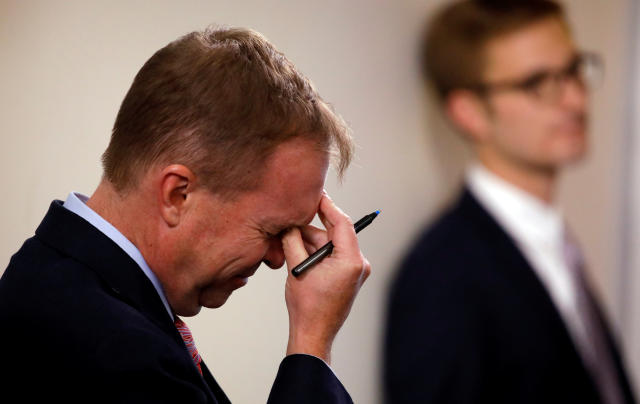
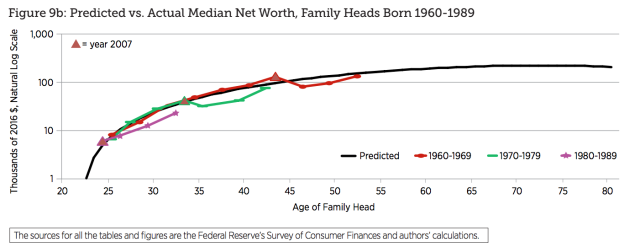
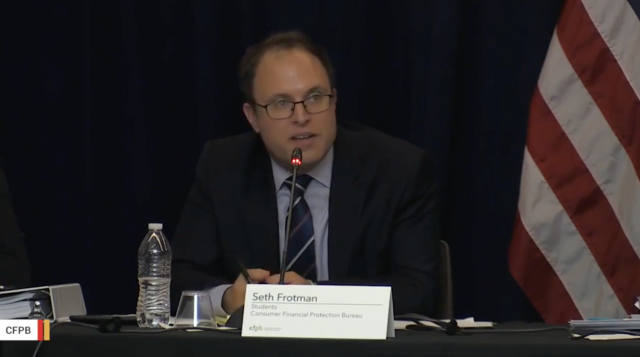
 Jones Gap State Park in Greenville County, South Carolina.
Jones Gap State Park in Greenville County, South Carolina. 

